TEAMS Center success will magnify at CAMLS
Clearly, USF is meeting a need. Since opening the TEAMS Center two years ago, the simulation training program has hosted more than 2,600 learners and provided more than 12,000 learner hours to healthcare professionals from varied disciplines throughout the Tampa Bay area and from as far away as China.
And those numbers are about to increase with the opening in March of USF’s Center for Advanced Medical Learning and Simulation (CAMLS), a state-of-the-art simulation center that includes high-tech robots for training surgeons.
The TEAMS (Team Education and Multidisciplinary Simulation) Center offers multidisciplinary team training for routine and crisis medical scenarios that replicate real-life medical encounters, from newborn babies in distress to adult patients experiencing cardiac arrest. This specialized training prepares healthcare providers for the multidisciplinary challenges faced in real-life patient encounters. In health care settings, seconds can translate into lives saved.
Inter-professional team training ultimately improves patient outcomes by improving healthcare professionals’ critical decision-making skills and ability to apply those skills effectively, said Laura Haubner, MD, medical director of the TEAMS Center.
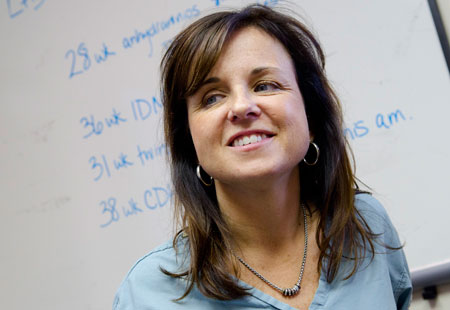
Dr. Laura Haubner
“This type of training is having a huge impact on the level of care provided to patients and offers them improved safety and better outcomes,” she said. “The Institute of Medicine has found that most medical errors are based on insufficient teamwork and miscommunication, not lack of knowledge. The TEAMS program is helping healthcare professionals learn to work more effectively in teams, refine skills without risk to real patients, and provide care safely to patients.”
The TEAMS Center is serving primarily emergency medicine, internal medicine, neonatology, obstetrics, and pediatrics. With more than 50 different activities and courses – many on a recurring basis – the Center is now nearly always booked to capacity training physicians, nurses, physician assistants, respiratory therapists and nursing technicians.
“We are completely learner focused and know ahead of time who is coming so that our scenarios accurately reflect their working world,” Dr. Haubner said. “This is adult education at its best.”
USF’s new home for top simulation training
Currently, the TEAMS Center is located in the old Pediatrics first-floor clinic in the 17 Davis building on Davis Islands. When CAMLS opens in downtown Tampa, the TEAMS Center will be part of the Virtual Patient Care Center, one of several programs offering a wide-range of simulation training.
“One of the many benefits CAMLS will bring is its realistic simulation, far more realistic than our current,” said Dr. Haubner, who is also Clinical Director for Simulation at CAMLS. “As much as TEAMS has helped area healthcare professionals fine-tune their skills, CAMLS will allow an even better, more realistic experience as well as increased collaboration among the members of USF”s Simulation Consortium. USF is ahead of most academic medical programs by offering these programs and we intend to use it to define health professional competencies, innovating current training paradigms.”
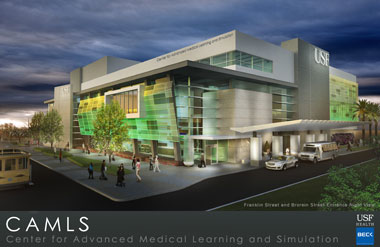
CAMLS in downtown Tampa is due to open in February.
The new 90,000-square-foot facility will greatly expand the simulation training USF offers, by bringing together under one roof the many programs housed in various departments throughout USF Health, as well as expand to offer surgical training and robotic training programs. Among the programs coming together are USF Health’s five simulation centers (USF Health Simulation Center at Tampa General Hospital, daVinci Center for Computer-Assisted Surgery, TEAMS Center, Center for Advanced Clinical Learning at the College of Medicine (CACL), and Center for Virtual Simulation and Clinical Excellence (VSCE) at the College of Nursing).
The building also will feature a 2,000 square-foot auditorium, a 6,000 square-foot laboratory for interdisciplinary research, and one floor for general purpose classroom space.
CAMLS will not only train doctors, nurses and other healthcare providers to work side-by-side, perfecting the teamwork and communication skills vital to top-quality medicine, but also train surgeons from around the country on how to perform robotic, computer-assisted, and image-guided surgeries.
Time ticks by while saving lives
At a recent training session in the current TEAMS Center, a team of six professionals from Tampa General Hospital was working on several labor-and-delivery room scenarios.
Mostly respiratory technicians and nurses, team members treated each scenario as real, even donning gloves and masks. Six cameras followed their every move throughout the room and sensitive microphones picked up their every word.
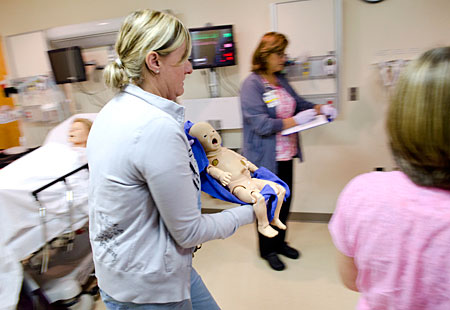
In one scenario, a premature baby was not breathing.
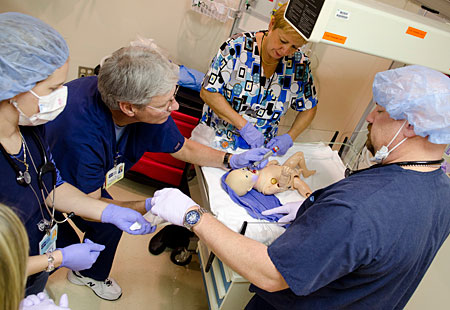
As the team worked to save the mannequin newborn in distress, they spoke to each other in short blurbs of orders, vital statistics and responses.
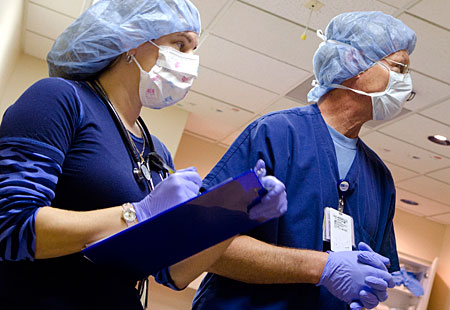
A ‘scribe’ took notes, writing down the details of the activity, including vitals, procedures taken, medications and their dosages, and noting the time along the way.
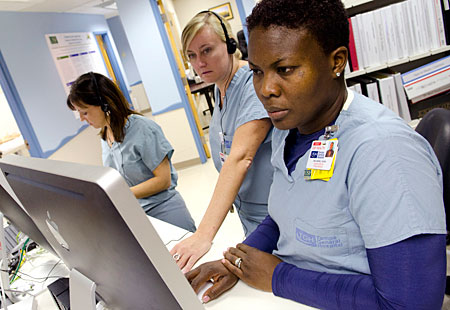
The TEAMS staff observes from another room how the healthcare team reacts. From left Dr. Haubner, Christine Airey, RN, MSN, and Nikki Campbell, RN, MSN.
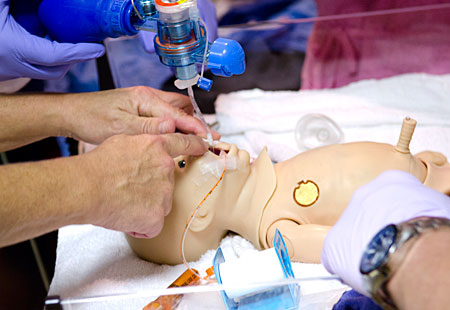
It was a team working together to save a patient. But there were gaps in communication and time lapses as single team members conducted various procedures, like inserting a breathing tube down the newborn’s throat.
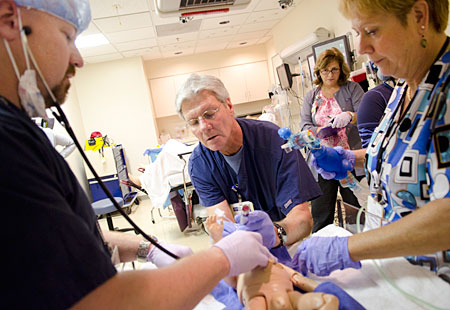
The procedure (intubation) was taking longer than expected; the provider performing it was fixated on the task and not cognizant of the time and potential compromise to the patient. This is where team members must support each other and communicate their concerns; mutual support is a vital teamwork skill. Time ticked by. No one suggested for someone to use a manual airbag to keep the newborn’s lungs going while the technician regrouped for a second attempt. Afterall, he is a very experienced provider and should not need guidance. There were only vague attempts to alert him of the time.
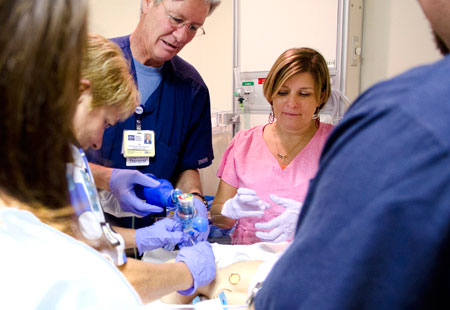
The new tube was successfully inserted, but the team’s takeaway message later as they watched the video replay with Dr. Haubner was that the process had less to do with technical knowledge, and more to do with basic human interaction. Specifically, providing mutual support to team members. The post-scenario discussion allows the team to dissect their work and see quite obviously with the video and audio how they can improve.
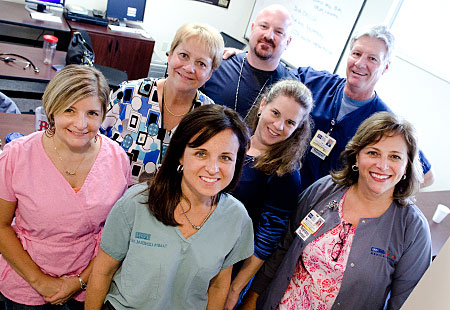
“This team is the cream of the crop,” Dr. Haubner said. “Collectively, they are some of the most experienced healthcare providers in TGH’s NICU and they know what to do. They didn’t trip up as much as I tried to trip them up. They shined bright today but there is always room for improvement.”
The ultimate goal is safe and efficient outcomes
Simulation team training works on group dynamics, leadership, communication, decision making, all while working under pressure to support, protect and save the patient. The recent focus on this type of training in medicine goes to the heart of the profession: offer safe and efficient outcomes.
Many times, the workplace, with real patients, is the first place many healthcare professionals work together in teams. More and more schools of medicine and nursing are teaching their students in cross-discipline teams, training them in realistic environments but with simulated patients, and providing them the valuable experience of working together before real patients are put at risk. Patients are not put at risk during their learning curves.
TEAMS Center has been used by hundreds of USF faculty, residents and fellows, as well advanced registered nurses, respiratory therapists. The program is operated by the Department of Pediatrics with the support of the Office of Graduate Medical Education.
Story by Sarah A. Worth, photos by Eric Younghans, and video by Amy Mariani, USF Health Office of Communications

